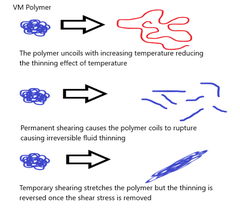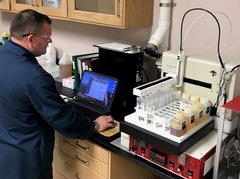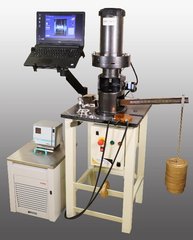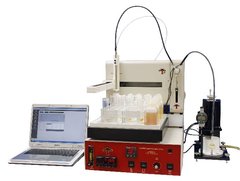ASTM D-6186 Oxidation Induction Time of Lubricating Oils by Pressure Differential Scanning Calorimetry (PDSC)
Some greases and oils react with atmospheric oxygen to produce insoluble gums and sludges, which may decrease the performance of the lubricant. To lessen the rate of oxidation, antioxidants are added. This test may be used to compare antioxidants and may predict the relative life of a lubricant. It requires a small amount of sample and it gives results in hours rather than days, weeks or even months as required by other tests.
A small quantity of grease (ASTM D-5483) or oil (ASTM D-6186) is heated to a specified temperature and then pressurized with oxygen. The pressure and temperature are maintained until an exothermic reaction occurs, up to 120 minutes. If the reaction occurs in less than ten minutes, a lower temperature should be tested as per the method (210ºC, 180ºC, 155ºC for grease and 210ºC, 180ºC, 155ºC, 130ºC for oil). The time from pressurization to exotherm is reported.
KRL Testing:
Shear Stability and Viscosity Loss
Shear stability is an important aspect of lubrication. Most multigrade lubricants are formulated with viscosity modifiers in order to increase the viscosity index (VI) to ensure the lubricant can provide a sufficient film thickness to protect the equipment or engine from wear. Viscosity modifiers (VM) tend to be polymer based chemistry that are susceptible to shear thinning. When a lubricant undergoes shear thinning, the viscosity of the fluid can be lowered by an entire ISO grade leaving moving parts in danger of wear or seizure. To ensure the stability of the fluid’s viscosity, tests are performed to analyze behavior under shear stress and temperature.

There are two types of viscosity loss from shear, temporary and permanent. Temporary viscosity loss is where polymers in the fluid are stretched which cause thinning. However, this thinning is reversible once the shear stress is removed. Permanent viscosity loss is not reversible as shearing the fluid causes breakdown of the polymer by rupturing the macromolecular chains. When the shear stress is removed, the viscosity remains lower and never returns to the level intended when the lubricant was formulated. Shear stability is a key attribute lubricant formulators work to optimize based on the requirements of the engine manufacturers as new technologies are developed.
KRL (Tapered Roller Bearing)
The KRL shear test uses a tapered rolling bearing in a cup fitted to a four ball instrument. Load is applied to the bearings as they are rotated at a certain RPM for a specified length of time. The test is typically run for 20 hours. KRL is considered to be one of the most severe shear tests and is used for driveline fluids and gear lubricants. The unit can perform standard methods such as CEC L-45-A-99, DIN 51350/6, and ISO 26422:2014. Savant offers CEC L-45-A-99 Modified for KRL testing.
Viscosity Loss
With each of the shear degradation methods, the viscosity is analyzed before and after the permanent shearing of the fluid. The fluid can be analyzed with ASTM D445 Kinematic Viscosity to determine the Permanent Shear Stability Index, per ASTM D6022. The fluid viscosity can also be analyzed under high temperature high shear (HTHS) conditions using the Tapered Bearing Simulator (TBS) and a low shear rotational viscometer.
Before and after viscosity values at both high shear and low shear rates are used to construct a Viscosity Loss Profile (VLP) from which the overall viscosity loss can be uniquely calculated and visualized. The VLP gives a simple visual appraisal of a fluid’s efficiency and effectiveness. Many examples of this data can be accessed through the Institute of Materials Online Database.






